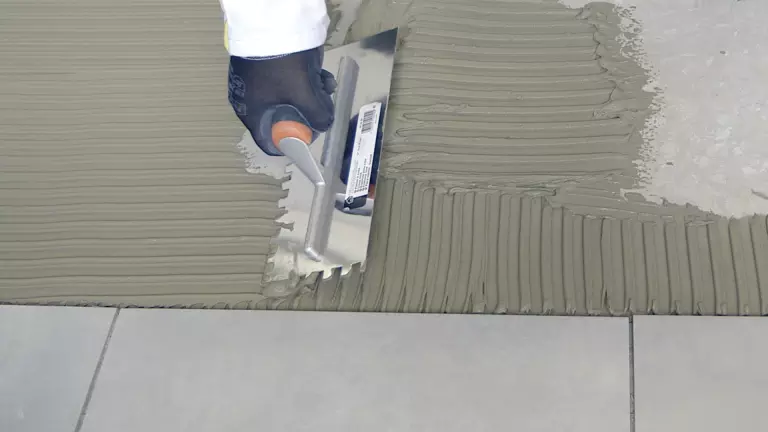When embarking on a tiling project, one of the most common questions is, “How much tile adhesive do I need?” Calculating the correct amount of adhesive is crucial for ensuring a successful installation without running out of materials or over-purchasing. This guide will help you determine the right amount of tile adhesive for your project, taking into account various factors that influence the quantity required.
Understanding Tile Adhesive
Tile adhesive, also known as thin-set or mortar, is used to bond tiles to surfaces. The type and amount of adhesive you need can vary depending on the type of tiles you are using, the size of the tiles, the surface you are tiling, and the method of application. You can find out more about what the different codes on tile adhesive mean here.
Factors Influencing Tile Adhesive Quantity
Several factors affect how much tile adhesive you’ll need for your project:
- Tile Size: Larger tiles require more adhesive than smaller ones due to their increased surface area.
- Tile Type: Different materials (e.g., ceramic, porcelain, natural stone) may require different amounts of adhesive.
- Surface Type: The condition and type of the surface you’re tiling (e.g., concrete, wood, plasterboard) can influence adhesive requirements.
- Application Method: The trowel size and notching pattern you use will affect the amount of adhesive needed.
- Tile Layout: Whether you’re tiling a wall, floor, or a complex pattern can impact adhesive use.
Calculating Tile Adhesive Needs
Here are steps to help you calculate the amount of tile adhesive required for your project:
Step 1: Measure the Area
Measure the length and width of the area you plan to tile to determine the total square meterage. For example, if you’re tiling a floor that is 3 metres long and 2.5 metres wide, the area is 7.5 square metres.
Step 2: Determine the Tile Size and Coverage
Tile adhesive manufacturers typically provide coverage information on the packaging. For example, a 20kg bag of adhesive might cover 5 to 7 square metres for standard-sized tiles (30×30 centimetres). Smaller tiles or more intricate patterns might reduce coverage.
Step 3: Adjust for Application Method
The size of the trowel you use will affect how much adhesive you need. A larger trowel with deeper notches will use more adhesive. Here are some common trowel sizes and their typical coverage:
- 6mm square notch trowel: Covers approximately 6 to 7 square metres per 20kg bag.
- 10mm square notch trowel: Covers approximately 4 to 5 square metres per 20kg bag.
- 12mm square notch trowel: Covers approximately 3 to 4 square metres per 20kg bag.
Step 4: Calculate the Total Adhesive Needed
Divide the total square meterage by the coverage per bag to determine how many bags of adhesive you need. For example, if your project area is 10 square metres and you are using a 6mm trowel with a coverage of 6 to 7 square metres per bag, you would need approximately 2 bags of adhesive.
What Size Trowel Notch Do I Need for Tiling?
Choosing the right trowel notch size is essential for ensuring proper adhesive coverage. The general rule of thumb is:
- 6mm notch: Suitable for small tiles up to 100 x 100mm.
- 8mm notch: Suitable for medium-sized tiles up to 200 x 200mm.
- 10mm notch: Suitable for larger tiles up to 300 x 300mm.
- 12mm notch: Suitable for large format tiles over 300 x300mm or for uneven surfaces.
Example Calculation
Let’s say you’re tiling a 15-square-metre floor with 30 x 30 centimetre ceramic tiles and using a 10mm trowel. The adhesive packaging states that one 20kg bag covers 4 to 5 square metres.
- Total Area: 15 square metres
- Coverage per Bag: 4 to 5 square metres
- Bags Needed: 15 square metres / 4.5 square metres (average coverage) = 3.33 bags
In this case, you would need to purchase 4 bags of adhesive to ensure you have enough to complete the project, accounting for any waste or variations in coverage.
Tips for Buying Tile Adhesive
- Buy a Little Extra: It’s always a good idea to purchase a bit more adhesive than you think you’ll need. This accounts for any mistakes, waste, or unforeseen issues. However, keep in mind that most suppliers do not accept returns of perishable products like tile adhesive because they cannot verify the storage conditions.
- Check Manufacturer Recommendations: Always check the manufacturer’s recommendations for your specific tile and adhesive type.
- Consider the Surface: If you’re tiling over a rough or uneven surface, you might need more adhesive to ensure proper bonding.
Conclusion
Calculating the right amount of tile adhesive for your project ensures a smooth and efficient installation process. By considering factors such as tile size, surface type, and application method, you can accurately determine how much adhesive you’ll need. Remember to always check the manufacturer’s guidelines and buy a little extra to cover any unexpected needs. With careful planning and the right materials, your tiling project will be a success.
For more DIY tips and tools, visit The Tilers Hub . Keep your tiling projects on track with our comprehensive guides and high-quality products.
